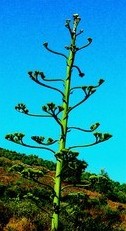 Looking around the campo you’ll see, thrusting skyward, what look like giant asparagus tips. These are the developing flower stalks of the agave americanum or century plant, pita in Spanish. It was once believed that the plants took one hundred years to flower, hence the misnomer; it is now recognized that climatic conditions and temperatures heavily influence the flowering, which can occur anytime from 8 years old up to the grand old age of 65 years.
Looking around the campo you’ll see, thrusting skyward, what look like giant asparagus tips. These are the developing flower stalks of the agave americanum or century plant, pita in Spanish. It was once believed that the plants took one hundred years to flower, hence the misnomer; it is now recognized that climatic conditions and temperatures heavily influence the flowering, which can occur anytime from 8 years old up to the grand old age of 65 years.
With some 300 species, they are native to southern US, Mexico, parts of South America and the Carribean. They were cultivated as long back as 10,000 years ago and were regarded as one of the most important crops with a multitude of uses – to make bread, beverages and alcoholic drinks, honey, vinegar, sugar, conserves, soap and a wide range of medicines. Their fibre made paper and brushes to write with, sisal to make a range of ropes and nets to hunt and fish, shoes and clothes, and thread for sewing. Their extremely sharp spines became sewing needles and nails. The strong flower stalks were used as beams in house construction and their tough dried leaves formed walls and roofs. Any surplus made fine firewood and the ashes were an excellent cleaning product! They were commonly planted as a stock-proof barrier and are often still seen here marking old boundaries or roadsides.
The name agave is from the Greek meaning ‘stately or noble’ and the Aztecs knew it as metl, translating as ‘magnificent’.






















